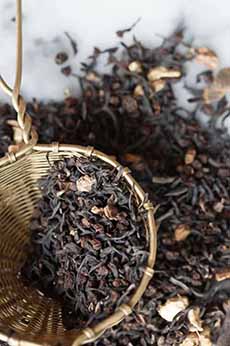TOP PICK OF THE WEEK: Chalo Chai Powdered Chai Mixes
|
|
Back in 2018 at a coffee and tea trade show, we came across Chalo Chai, a premium chai mix in classic masala plus three flavors. (If you’re not familiar with chai, check it out below). We loved all four varieties, and so did the SCA*, which named Chalo “Best Specialty Beverage.” The premium Chalo chai mixes were simply splendid—each flavor more charming than the last. Then, in a serendipitous search for chai on Amazon, we recently came across Chalo in all four flavors (click on the links for more information): The brand is a premix powder blend made from Assam tea and cane sugar. But until Chalo gets enough traction in the U.S., you’ll have to get to Belgium—as soon as the borders open up to travelers from the U.S. One of the co-founders of Chalo, Gita van den Boer, was born in India but was quickly adopted by a Belgian family, and has spent all her life in Belgium. As an adult, Gita visited India and discovered masala chai, a drink that could be found nowhere in Belgium. She co-founded Chalo with several business partners, and brought masala chai to Belgium and neighboring countries. In Hindi, “chalo” translates to “let’s go” or “hurry up.” In India, you’ll hear people saying “Chalo! Chalo!” while a vendor pours their tea. The monkey logo represents a prominent Hindu deity, Hanuman: a god of strength, victory and the ability to overcome all obstacles. That’s reason enough to have a cup of Chalo right now! In India the beverage is known as masala chai, or spiced tea: Masala is the Hindi word for spice and chai, as previously noted, is the Hindi word for tea. The drink is made from a strong black Indian tea (usually Assam), infused with milk, sugar and spices. The spices are commonly cardamom, cinnamon, ginger, peppercorn, clove and nutmeg. But people are free to flavor as they wish. Chocolate and licorice are also used; and, as you can see in Chalo’s flavors, lemongrass and vanilla. While chai is traditionally made from black tea, following food trends, green tea masala chai and rooibos masala chai have become popular. The precise origin of masala chai is lost in legend, but different sources date it back from 5,000 to 9,000 years. Some say it originated in what is now India, others attribute it to Thailand. But certainly, the drink began in an ancient royal court, which had access to expensive spices. It was created for the king as a cleansing, vivifying Ayurvedic† beverage. Initially, the spicy-sweet drink did not contain any tea leaves: It was a caffeine-free spiced drink, served hot or cold Recipes for the drink evolved to include a wide range of spices, prepared with different methods. Many centuries later, in 1835, the British established tea plantations in Assam, India. The black teas produced there were added to the local masala chai recipes. This was the first appearance of masala chai as we know it today: black tea, spices, sweetener and milk. However, this version was available only to wealthy locals. Tea was primarily an export product and was too expensive for most Indians. In the early 1900s, there was enough production that the British-owned Indian Tea Association began to promote the tea for consumption within India. |
|
|
The tea was still the most expensive ingredient, so vendors added a good amount of milk to keep the costs down. The result was most enjoyable, and masala chai’s popularity spread. In the 1960s, mechanical processing made tea affordable for everyone. Vendors on streets and trains sold it. Masala chai was also served at home, to welcome guests and at the Indian version of British afternoon tea: served at 4 p.m., with snack foods. Today, masala chai has spread worldwide (tea is the second-most consumed beverage in the world, after water). Just remember to ask for masala chai, shortened to chai in the U.S. “Chai tea” is erroneous: It translates to “tea tea” [source] . > A GLOSSARY OF TEA TYPES & TERMINOLOGY ________________ *SCA is the Specialty Coffee Association, which awarded Chalo the Best Specialty Beverage even though Chalo is tea, not coffee! †Ayurveda is a traditional Indian system of medicine, one of the world’s oldest holistic (“whole-body”) healing systems. Ayurvedic medicine aims to preserve health and wellness, preventing disease rather than treating it. To do so, it employs a holistic approach that aims for a delicate balance between the mind, body and spirit. |
||







